Integrin α3β1 in hair bulge stem cells modulates CCN2 expression and promotes skin tumorigenesis
- PMID: 32423907
- PMCID: PMC7240742
- DOI: 10.26508/lsa.202000645
Integrin α3β1 in hair bulge stem cells modulates CCN2 expression and promotes skin tumorigenesis
Abstract
Epidermal-specific deletion of integrin α3β1 almost completely prevents the formation of papillomas during 7,12-Dimethylbenz[ a ]anthracene/12- O -tetradecanoylphorbol-13-acetate (DMBA/TPA) two-stage skin carcinogenesis. This dramatic decrease in tumorigenesis was thought to be due to an egress and premature differentiation of α3β1-depleted hair bulge (HB) stem cells (SCs), previously considered to be the cancer cells-of-origin in the DMBA/TPA model. Using a reporter mouse line with inducible deletion of α3β1 in HBs, we show that HB SCs remain confined to their niche regardless of the presence of α3β1 and are largely absent from skin tumors. However, tumor formation was significantly decreased in mice deficient for α3β1 in HB SCs. RNA sequencing of HB SCs isolated from short-term DMBA/TPA-treated skin showed α3β1-dependent expression of the matricellular protein connective tissue growth factor (CCN2), which was confirmed in vitro, where CCN2 promoted colony formation and 3D growth of transformed keratinocytes. Together, these findings show that HBs contribute to skin tumorigenesis in an α3β1-dependent manner and suggest a role of HB SCs in creating a permissive environment for tumor growth through the modulation of CCN2 secretion.
© 2020 Ramovs et al.
Conflict of interest statement
The authors declare that they have no conflict of interest.
Figures





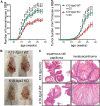

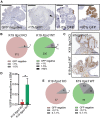

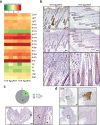
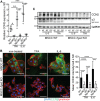

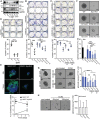

Similar articles
-
The epidermal integrin-mediated secretome regulates the skin microenvironment during tumorigenesis and repair.Matrix Biol. 2024 Dec;134:175-183. doi: 10.1016/j.matbio.2024.11.002. Epub 2024 Nov 2. Matrix Biol. 2024. PMID: 39491760 Review.
-
Loss of integrin α3 prevents skin tumor formation by promoting epidermal turnover and depletion of slow-cycling cells.Proc Natl Acad Sci U S A. 2012 Dec 26;109(52):21468-73. doi: 10.1073/pnas.1204614110. Epub 2012 Dec 10. Proc Natl Acad Sci U S A. 2012. PMID: 23236172 Free PMC article.
-
Integrin α3β1 Is a Key Regulator of Several Protumorigenic Pathways during Skin Carcinogenesis.J Invest Dermatol. 2021 Apr;141(4):732-741.e6. doi: 10.1016/j.jid.2020.07.024. Epub 2020 Aug 14. J Invest Dermatol. 2021. PMID: 32805217
-
Integrin α3β1 on Tumor Keratinocytes Is Essential to Maintain Tumor Growth and Promotes a Tumor-Supportive Keratinocyte Secretome.J Invest Dermatol. 2021 Jan;141(1):142-151.e6. doi: 10.1016/j.jid.2020.05.080. Epub 2020 May 23. J Invest Dermatol. 2021. PMID: 32454065 Free PMC article.
-
On the origin of epidermal cancers.Curr Mol Med. 2009 Apr;9(3):353-64. doi: 10.2174/156652409787847227. Curr Mol Med. 2009. PMID: 19355916 Review.
Cited by
-
Integrin α3β1 Represses Reelin Expression in Breast Cancer Cells to Promote Invasion.Cancers (Basel). 2021 Jan 19;13(2):344. doi: 10.3390/cancers13020344. Cancers (Basel). 2021. PMID: 33477804 Free PMC article.
-
The epidermal integrin-mediated secretome regulates the skin microenvironment during tumorigenesis and repair.Matrix Biol. 2024 Dec;134:175-183. doi: 10.1016/j.matbio.2024.11.002. Epub 2024 Nov 2. Matrix Biol. 2024. PMID: 39491760 Review.
-
Integrin signaling in tumor biology: mechanisms of intercellular crosstalk and emerging targeted therapies.PeerJ. 2025 May 7;13:e19328. doi: 10.7717/peerj.19328. eCollection 2025. PeerJ. 2025. PMID: 40352270 Free PMC article. Review.
-
Epidermal Integrin α3β1 Regulates Tumor-Derived Proteases BMP-1, Matrix Metalloprotease-9, and Matrix Metalloprotease-3.JID Innov. 2021 Apr 30;1(2):100017. doi: 10.1016/j.xjidi.2021.100017. eCollection 2021 Jun. JID Innov. 2021. PMID: 34909716 Free PMC article.
-
Double-sided niche regulation in skin stem cell and cancer: mechanisms and clinical applications.Mol Cancer. 2025 May 21;24(1):147. doi: 10.1186/s12943-025-02289-8. Mol Cancer. 2025. PMID: 40399946 Free PMC article. Review.
References
Publication types
MeSH terms
Substances
LinkOut - more resources
Full Text Sources
Medical
Molecular Biology Databases
Miscellaneous
